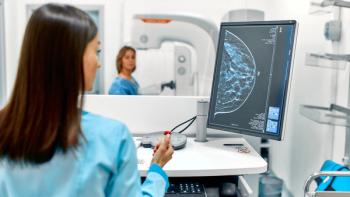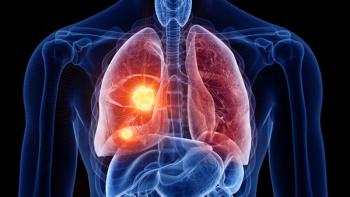
Breast Cancer Care During COVID-19: A Review of the Last Year
One year into the COVID-19 pandemic has allowed for some reflection on the different evolutions that the oncology community went through in response to the many challenges posed by the virus
One year into the COVID-19 pandemic has allowed for some reflection on the different evolutions that the oncology community went through in response to the many challenges posed by the virus.
Cancer screenings plummeted. Treatment plans were rapidly adapted to reduce the risk of unnecessary infection. The utility of telemedicine took the world by storm. Investigators from all over the globe joined the race to develop a vaccine, which was developed in record time. Now, providers everywhere are taking notes on what has been learned from the experience, while trying to determine the long-term implications of the global pandemic.
“This talk is almost in the form of an autopsy of what we went through rather than what we’re going through right now,” George W. Sledge, Jr, MD, said during a presentation delivered at the 38th Annual Miami Breast Cancer Conference®.1 “Clearly, what happened in terms of breast cancer management, was related to the severity of the COVID-19 outbreak at a local, and at a deep institutional level, where some healthcare systems tragically nearly collapsed under the weight of large numbers of hospitalizations and very sick patients [with the virus]; this, in turn, had direct effects on those of us who care for patients with cancer.”
In his presentation, Sledge, a professor of medicine in the Division of Oncology at Stanford University Medical Center and 2018 Giants of Cancer Care® award winner in breast cancer, walked through the impact of the pandemic on breast cancer screenings and management, highlighted advances made in vaccination and how this advance will impact those with this malignancy, and discussed how the virus may be a potential driver of immune-mediated breast cancer recurrence.
Patients With Cancer Are at Increased Risk for COVID-19
Data from a retrospective case-control analysis of patient electronic health records which comprised 73.4 million patients indicated that patients with cancer were at significantly increased risk for COVID-19 infection and worse outcomes.2
“It is commonly said that cancer increases one’s risk of coming down with COVID-19, and while this is true overall, recent cancer hugely increases one’s risk compared with all cancer risk,” Sledge said. “Why this might be the case is an interesting question. It may reflect the altered immune system in patients recently diagnosed with cancer; it may represent treatment effects that further reduce immunity; or it may reflect that these patients have many touches on the health care system, and therefore, are perhaps more likely to be tested for fairly minor symptoms vs someone in the general community.”
When looking closer at risk based on type of cancer, it was shown that the strongest risk association was for recently diagnosed leukemia (adjusted odds ratio [aOR], 12.16; 95% CI, 11.03-13.40; P <.001), followed by non-Hodgkin lymphoma (aOR, 8.54; 95% CI, 7.80-9.36; P < .01), and lung cancer (aOR, 7.66; 95% CI, 7.07-8.29; P <.001).
“However, a recent diagnosis of breast cancer increases one’s aOR of developing COVID-19 by somewhere over fivefold; it is certainly a significant increased risk,” Sledge noted.
Additionally, patients with cancer had a higher likelihood of hospitalization and death vs patients with COVID-19 who do not have cancer or those with cancer who do not have the virus.
Within that setting, it is clear that significant healthcare disparities exist with regard to African American patients, noted Sledge. Among patients with a recent cancer diagnosis, African Americans had a significantly higher risk for COVID-19 infection vs White patients, and this racial disparity was largest for breast cancer (aOR, 5.44; 95% CI, 4.69-6.31; P <.001).
Reductions in Cancer Screening May Have Long-Term Implications
In an early response to the growing number of COVID-19 cases in March 2020, the US government recommended that individuals avoid seeking nonurgent care to reduce the risk of community-based transmission of the virus and to avoid unnecessary use of medical resources.3 Organizations such as the American College of Radiology, the Society of Breast Imaging, and the American Cancer Society, among others, advised that asymptomatic women forego breast cancer screening appointments.
Findings have indicated that the use of radiologic imaging, including mammography, decreased in response to the pandemic. Although the effect of imaging delays continues to be uncertain, modelling is suggestive that there will be long-term implications of this decision, noted Sledge.
Data from the University of North Carolina have shown that the number of mammograms received following the start of the COVID-19 pandemic was lower than expected, with maximum reductions observed in March 2020. Use of screening mammography was 85.1% lower than expected (95% CI, -100.0% to -70.0%), while diagnostic mammography was 48.9% lower (95% CI, -71.7% to -26.2%). Decreases in the number of breast biopsies lagged behind reductions in screening and diagnostic mammography. In May 2020, use of biopsies was 40.9% lower than expected (95% CI, -57.6% to -24.3%). However, rates do appear to be returning to, or exceeding, expected levels.
Another study, which utilized a large medical claims clearinghouse database accounting for 5% to 7% of the Medicare fee-for-service population, also showed reductions in cancer screening.4 In April 2020, the peak of the pandemic, screening for breast cancer was lower by 85%.
“Downstream of this, what one sees, again on the same Medicare databases, are significant reductions in terms of billing for select oncology products and particular reductions in terms of chemotherapy administration,” Sledge said.
Specifically, billing frequency for oncology products dropped by 26% in April 2020 and 31% in July 2020.
“In part, this may reflect patients who weren't getting adjuvant chemotherapy or weren’t receiving it in a timely fashion perhaps because of delays in surgery and screening mammography,” Sledge said. “However, this may also reflect the fact that medical oncologists and many healthcare systems were intentionally using less chemotherapy because of concerns regarding immunosuppression…Since we give these drugs for a reason, one has to have concerns that this could have a long-term effect on outcomes of patients with breast cancer.”
Principles of Breast Cancer Management Amidst the Pandemic
In response to the pandemic, many oncologists and healthcare systems worked vigorously to adjust treatment plans to prevent unnecessary exposure to the virus, while continuing to treat patients with cancer for their disease.
Some of the principles Sledge shared included:
- Try to do what you “normally” would, based on local conditions
- Endocrine therapy and radiation treatment can safely be utilized
- It is acceptable to defer any given therapy in several situations
- Consider utilizing chemotherapy regimens that are less likely to make patients very sick or result in hospitalization, such as weekly paclitaxel, ado-trastuzumab emtansine (Kadcyla; T-DM1), and growth factors
- Local prevalence of the virus may cause local variation in clinical practice
- Specific clinical challenges were faced with regard to dyspnea and fever management
Recommendations for Outpatient Visits: Prioritization of Care
The COVID-19 Pandemic Breast Cancer Consortium issued a special communication in which they shared recommendations from several experts of many cancer care organizations regarding the prioritization of care for patients with breast cancer during the pandemic.5
Patients considered to be “Priority A” had conditions that were considered to be immediately life threatening or were symptomatic and thought to require urgent treatment; these patients included postoperative patients who were clinically unstable and those with potential medical oncology emergencies that required in-person assessment.
Those in the “Priority B” bracket were those with conditions that do not need immediate treatment but should begin treatment prior to the end of the pandemic; this included those with newly diagnosed disease, patients with new concerns, and those who were receiving intravenous chemotherapy, finishing neoadjuvant treatment, postoperative patients who needed routine follow-up, and those who required evaluation for radiotherapy.
Lastly, patients who were considered to be “Priority C” had conditions that could safely be delayed until after the pandemic had concluded; this included patients who required routine follow-up for nonurgent conditions, any survivorship visits, or high-risk screening that can be delayed.
“Most visits should be conducted using telemedicine,” said Sledge. “We needed to consider the risk of SARS-CoV-2 transmission if conducting visits in person. Increased caution was needed for in-person visits with patients with comorbidities or higher risk of complications for COVID-19.”
Recommendations for Advanced-Stage Invasive Breast Cancer
In response to the pandemic, many worked on adjusting dose/schedule of systemic treatments in an effort to decrease in-person visits, the need for bloodwork, and to prevent serious toxicities. Moreover, many routine staging scans were delayed for patients without progressive disease.
For patients with estrogen receptor–positive cancer, the toxicity concerns that come with oral targeted therapies such as CDK4/6 inhibitors, mTOR inhibitors, or PIK3CA inhibitors, needed to be considered. First- or second-line CDK4/6 inhibitors could potentially be deferred in patients who were determined to more likely maintain disease control with endocrine therapy alone.
“If we have a [patient with] HER2-positive [disease], can we safely increase the period between administration of monoclonal antibodies and ADCs?” Sledge asked. “I think the answer to that question is, fairly clearly, a yes.”
For patients with HER2-positive disease, the Consortium recommended that dosing intervals could be increased for agents like trastuzumab (Herceptin), pertuzumab (Perjeta), and antibody-drug conjugates (ADCs). Additionally, the interruption of trastuzumab-based maintenance in patients who have had tumor control for longer than 2 years and minimal residual disease burden, can also be considered.
Telemedicine Takes Center Stage
“What has been clear is there has been a significant increase in terms of telemedicine,” said Sledge. “I suspect that this may be a permanent effect. I've gone from essentially [using] no telemedicine, to telemedicine being a routine part of my clinical practice. I’ll use more telemedicine [in the future] for my patients who come from 4 hours away for a routine follow-up visit.”
In response to the pandemic, an increasing number of health systems utilized telemedicine practices to continue to deliver lifesaving cancer care while preventing unnecessary exposure to the virus. The Kaiser Permanente Northern California shared their experience with telehealth to help inform rapid, effective rollout of these practices at other oncology institutions.6
They detailed how certain clinical visits and consultations like follow-up visits and clinical trial visits can be transitioned to telehealth. They also shared that certain assessments like surgical would evaluation or toxicity evaluations can be transitioned to telehealth. Opportunities for telehealth as it relates to palliative care includes symptom management services or palliative consultations. In the realm of supportive care, social work support, psychological care, tobacco or smoking cessation, nutrition consultation, and more can all be conducted virtually. Patient education services are also available through telehealth services.
COVID-19 Triggers Shift in Treatment Patterns
“We’ve seen shifting breast cancer treatment patterns,” said Sledge. “Reduced breast imaging and reduced breast biopsies and diagnosis have certainly occurred. We also use more neoadjuvant therapy, particularly more neoadjuvant endocrine therapy. There has also been an effect in terms of surgical procedures, with shorter operating room times being preferred. This has led, in turn, to reductions in reconstructive surgeries, reductions in panel testing, and the increased use of telehealth.”
Recommendations for COVID-19 Vaccination in Breast Cancer
In December 2020, the FDA granted an emergency use authorization to BNT162b2 as the first vaccine to prevent COVID-19 in individuals aged 16 years and older. Later that month, the regulatory agency also granted an emergency use authorization to the Moderna COVID-19 vaccine to prevent the virus in patients aged 18 years of age and older.
With the Moderna vaccine, there have been reports of axillary tenderness and swelling in 11.6% of vaccinated patients vs 5% in those who received placebo following the first dose, and 16% vs 4.3%, respectively, following dose 2 of the vaccine. These effects tend to occur 2 to 4 days following vaccination and persist for 1 to 2 days, according to Sledge.
“The Society of Breast Imaging recommends scheduling imaging pre-vaccination or 4 to 6 weeks post the second dose and following an appropriate diagnostic workup of if one has swelling and having the patient come back for a follow-up exam,” Sledge noted.
COVID-19 Long Haulers
Severe COVID-19 infection can result in the hyperactivation of immune cells, leading to lung inflammation.7 Findings from recent studies have indicated that the virus elicits the production of factors, like neutrophil extracellular traps (NETs) that have previously been implicated in the reawakening of dormant breast cancer cells. Thus, the presence of NETs and a pro-inflammatory microenvironment can encourage disease reactivation, which could increase the risk of pulmonary metastases.
“COVID-19 ‘long haulers’ are going to have chronic health issues, which are multiorgan in nature and currently poorly defined. [Understanding] how these syndromes will impact patients [with cancer] is also poorly defined but may prove important for a significant portion of the population,” concluded Sledge. “Some have hypothesized that COVID-19 could be a potential driver of immune-mediated breast cancer recurrence; it’s certainly a long-term concern.”
References
- Sledge Jr, GW. COVID-19 and cancer. Presented at: 38th Annual Miami Breast Cancer Conference; March 4-7, 2021; Virtual. Accessed March 7, 2021.
- Wang Q, Berger NA, Xu R, et al. Analyses of risk, racial disparity, and outcomes among US patients with cancer and COVID-19 infection. JAMA Oncol. 2021;7(2):220-227. doi:10.1001/jamaoncol.2020.6178
- Nyante SJ, Benefield TS, Kuzmiak CM, et al. Population-level impact of coronavirus disease 2019 on breast cancer screening and diagnostic procedures. Cancer. Published online February 26, 2021. doi:10.1002/cncr.33460
- Patt D, Gordan L, Diaz M, et al. Impact of COVID-19 on cancer care: how the pandemic is delaying cancer diagnosis and treatment for American seniors. JCO Clin Cancer Inform. 2020;1059-1071. doi:10.1200/CCI.20.00134
- Dietz JR, Moran MS, Isakoff SJ, et al. Recommendations for prioritization, treatment, and triage of breast cancer patients during the COVID-19 pandemic. the COVID-19 pandemic breast cancer consortium. Breast Cancer Res Treat. 2020;181(3):487-497. doi:10.1007/s10549-020-05644-z
- Liu R, Sundaresan T, Reed ME, et al. Telehealth in oncology during the COVID-19 outbreak: bringing the house call back virtually. JCO Oncol Pract. 2020;16(6):289-293. doi:10.1200/OP.20.00199
- Francescangeli F, De Angelis ML, Zeuner A, et al. Breast Cancer Res. 2020;22(1):117. doi:10.1186/s15058-020-01360-0
This article was originally published on OncLive as, "
Newsletter
Knowledge is power. Don’t miss the most recent breakthroughs in cancer care.




